Kevtoberfest #6 Gulgong
When decimal currency was introduced in Australia in 1966, the newly minted bank notes featured images of notable Australians and scenes connected with their lives. The town of Gulgong, in central New South Wales, was depicted on the original ten dollar note. What was it about Gulgong that distinguished it from countless other small country towns?
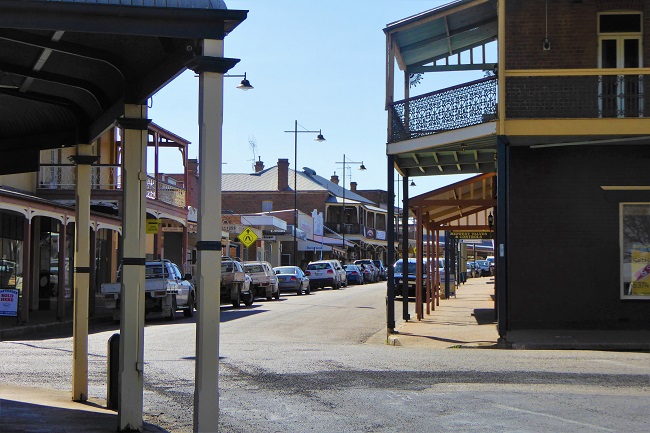
After gold was discovered in 1870 Gulgong flourished and the population rose to more than 20,000, although today it’s closer to 2,500. The narrow streets are lined with distinctive 19th century buildings, whose wide, shady verandas and ornate wrought iron lacework are heritage listed.
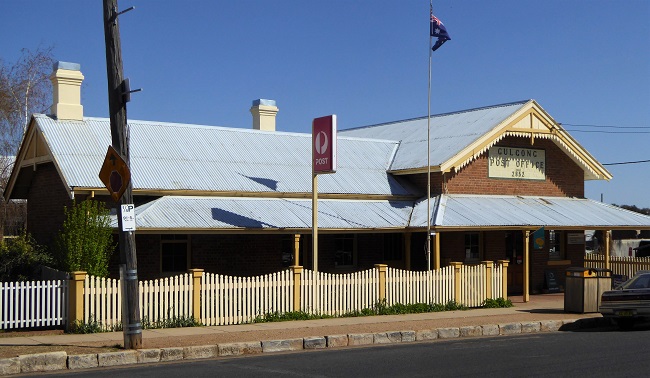
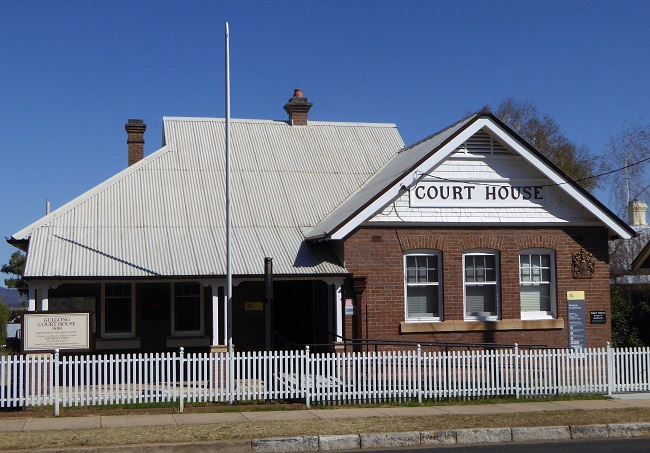
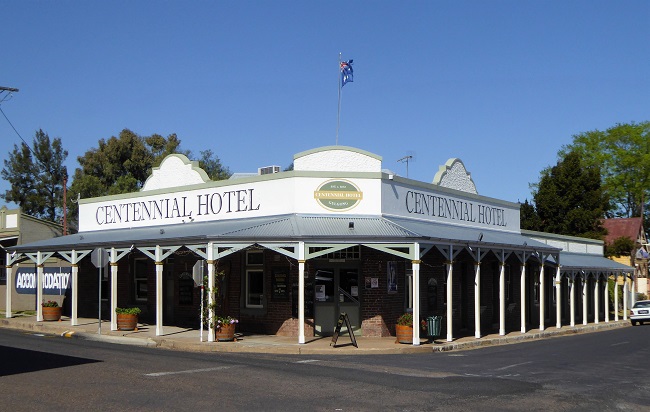

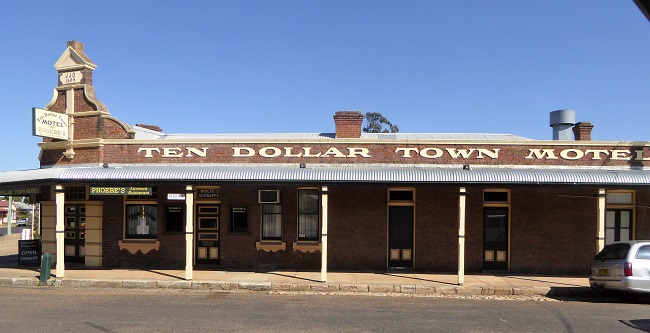
Australian opera diva Dame Nellie Melba once performed at Gulgong’s Prince of Wales Opera House. Built in 1871, it’s the oldest performing arts building still in use in the southern hemisphere.

While the colonial architecture of Gulgong is historically significant, it was the town’s connection with one of Australia’s best known writers which led to its inclusion on our currency. Henry Lawson – poet, story teller and bush balladeer, was born on the gold fields of Grenfell. In 1873, he moved with his family to the Gulgong district, following his father’s relentless search for riches. Henry went to school at nearby Eurunderee and spent his childhood in the area before moving to Sydney with his mother in 1883. His experiences of country life influenced his writing and Henry often referred in his work to the people and places he knew so well.
Gulgong celebrates its connection with Henry Lawson with an annual festival in June and a small but comprehensive museum. At The Henry Lawson Centre, once the Salvation Army Hall, a collection of documents, photographs and copies of his works tells the narrative of his life, from his birth to his sad decline into alcoholism and poverty.
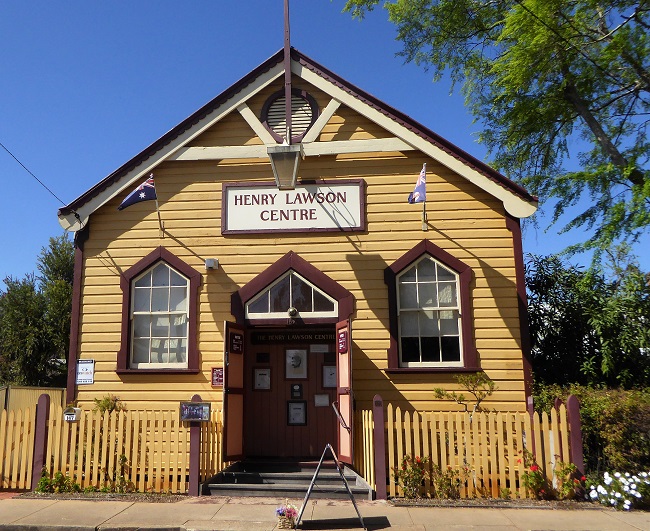
Best known for poems like The Ballad of the Drover and Andy’s Gone With Cattle, Henry Lawson remains forever remembered, along with the town of Gulgong, on Australia’s first ten dollar note.
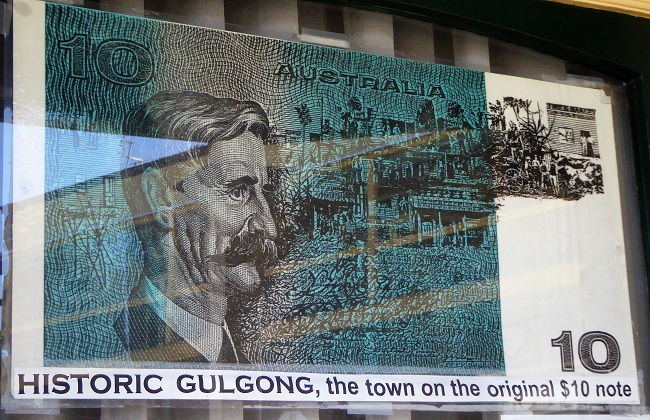
Join Restless Jo for Monday Walks
I’d never heard of it, Carol, but it looks a nice little town wth an interesting bit of history. Many thanks for sharing. 🙂 🙂
LikeLiked by 2 people
We spent several hours wandering the streets looking at these lovely old buildings, Jo.
LikeLiked by 1 person
Well there you go, I’ve just learnt about the origins of the ten dollar note. What an interesting place.
LikeLiked by 2 people
Of course, that note is no longer in production and the newest one is made of plastic. That’s progress for you!
LikeLiked by 1 person
Shame really.
LikeLike
It’s too bad about the fate of Henry Lawson, and sad that the town has diminished from its earlier heyday. I love old towns such as this.
I am behind again! Need to go back and play catch-up. I don’t know how this always happens. 🙂
LikeLiked by 2 people
I didn’t know how sad his life was until we went to this museum. He suffered a childhood illness and lost his hearing, then went through several very painful treatments in an effort to have it restored. His mother didn’t really like him and his marriage failed miserably. He was very successful as a writer but that wasn’t enough to stem his addiction to alcohol. In his later life, he was supported by a wonderful landlady who took care of him. I read that he would give away his money to homeless people and then not be able to buy food for himself. That was sad.
LikeLike
That’s a very sad story, Carol. So much suffering in this world.
LikeLike
“The Ballad of the Drover” is such an evocative and sad poem. And so Australian. I love this type of country town; the architecture; the history; to me this is the heart of Australia not the suburban bustling metropolises. But I may have said this to you before 😀 😀
LikeLiked by 2 people
It is a beautiful poem and really shows how hard life was. I wonder if it was based on a true event. We love these towns too. Gulgong and Nundle and other small town like these have so much history. I always say to Glen we could spend several days at any of them.
LikeLike
A couple of thoughts Carol. Firstly, what was the currency before decimalisation? Was it Australian pounds and shillings, similar to the UK? Second, I am struck by the buildings in this town. Despite the links with England, if I didn’t know you were writing about Australia, I would have looked at the pictures and thought “USA”. Did the presence of gold attract prospectors from America, who brought over their house designs too, perhaps?
LikeLiked by 2 people
We used the imperial UK system with Australian symbols. I was only 4 when it changed over so I can’t remember those coins. Look here https://www.ramint.gov.au/sites/default/files/Before%20decimal%20currency.pdf
As for the architecture, these buildings are all typical of colonial style. The wide verandas were designed to provide maximum shade and the wrought iron lace is typical of hotels of that era. I think by the time these buildings were constructed the designs were definitely influenced by the climate, which is more like California than England. That could be where the similarity lies. Again, I found a website you might be interested in. https://www.australia.gov.au/about-australia/australian-story/austn-architecture
Great questions. You set me thinking as well!
LikeLiked by 2 people
Thanks Carol, I’ll check these out when I get a space sec or two.
LikeLiked by 1 person
These old gold mining towns are wonderful pieces of history aren’t they – this one is being beautifully kept!
LikeLiked by 2 people
The buildings are so well maintained CC and everyone we spoke to was very nice, especially the lady at the museum. She was very sympathetic about Henry Lawson, who didn’t have a very happy life despite his success.
LikeLiked by 1 person
I was thinking about that when I commented but decided to leave it out ET – you intuited 🙂 So many of our artists and writers have battles with addictions and depression. I think it is because they are such sensitive souls and self medicate to destruction. It’s hard to be a sensitive man in this world! It makes the work so much more precious don’t you think?
LikeLiked by 1 person
Part of his problem was that he lost his hearing as a child. Also his mother wasn’t very nice to him. It was interesting to read about his state funeral, the first ever given to anyone other than a politician. So sad that he didn’t know how much he was loved.
LikeLiked by 3 people
I’d only known the link from man to poetry, and had never thought beyond that. Now, knowing a bit about the man, the poetry will mean more. And I’d never even noticed there was town on that $10 note.
LikeLiked by 2 people
It was so interesting to read the story of Henry’s life. I felt so sympathetic for him, knowing that his mother was never satisfied.
LikeLiked by 1 person
I love the towns with their original verandas. It is good to see the history preserved and celebrated. Another place in my own country I had no idea about. Thanks for sharing the story. Louise
LikeLiked by 2 people
Aren’t these old buildings wonderful. Glad you enjoyed seeing them with me, Louise.
LikeLike
I’ve only heard of Gulgong in passing. It looks like a cute little town with a nice history!
LikeLiked by 2 people
It is a pretty little place to visit, Lorraine. We didn’t stop anywhere to eat, but I’m sure you would find a good restaurant!
LikeLike
Well I never knew! Great info.
LikeLiked by 2 people
I doubt any of us take much notice of the images on our money. Our notes and coins are much more interesting than those of some of the countries we’ve visited.
LikeLiked by 1 person
So true and it’s getting rarer to carry cash!
LikeLiked by 1 person
It always intrigues us when we travel to a country where cash is still the main method of payment.
LikeLike
I wish I’d been clever enough to save some of that first decimal currency. Mind you, we no doubt wouldn’t have any left over at the end of the pay period to save, back in those days.
LikeLiked by 2 people
I was only four when the changeover happened but I think my dad, who is a coin collector has some. I do have some one and two dollar notes though.
LikeLiked by 1 person
I even spent all of those, spendthrift obviously! 🙂
We were lucky to move from Canada just as the changeover was happening, so we didn’t have to learn the old system. Lots of stuff was still marked with the old currency, as well as the new.
LikeLiked by 1 person
I only remember the new money. 😀
LikeLiked by 1 person
Interesting history, and I love the architecture. You do have a big, beautiful country to pull good stories from, and I thank you for sharing them. 🙂
LikeLiked by 3 people
Thanks Judy. I have lots more stories about this trip to come, so I’m pleased to know you’re enjoying them.
LikeLiked by 1 person
Pingback: Jo’s Monday walk : Hetton Lyons Country Park | restlessjo
This is the first time I am hearing about Gulgong and I’ve learned a lot from your post, Carol. How many days would be enough to see all the highlights there?
LikeLiked by 2 people
You would only need a half a day in Gulgong but a little further south is Mudgee. We spent a couple of days there and my next post will be about that. I’m pleased to hear you’re learning more about Australia from my posts Agness.
LikeLike
I love his poetry but never realised what a tragic life he had. Always fascinating finding these little gems of places when travelling.
LikeLiked by 2 people
We didn’t know his story either and felt quite sad to read how difficult the last part of his life was. This little museum was a real bonus.
LikeLiked by 1 person
Great post and lovely photos!
Maybe it’s a town that I’ll visit when doing the trip around Australia in a MH/campervan/or other 😉
LikeLiked by 2 people
Definitely a town to include on your itinerary!
LikeLiked by 1 person
I had never heard of it but fun to know the history and the fact that it made the ten dollar bill.
LikeLiked by 2 people
It made me wonder about the stories on our other notes. I must investigate further. I know the people but there will be background images on them as well.
LikeLike
What a sad end to his life, but at least he wasn’t forgotten. Not too many people get their faces on bank notes. 😀
LikeLiked by 1 person
He was quite a celebrity in his time, but gave away every cent he earned.
LikeLiked by 1 person
Thank You for this interesting post! I did not had any idea about Gulgong. 🙂
LikeLiked by 2 people
It’s not a town you would find in a tourist brochure.
LikeLiked by 1 person
The town looks wonderful – very ‘olden days’ and the sort of thing I’d expect to see cropping up in a film. 🙂
LikeLiked by 2 people
I thought that too. It reminded me of old cowboy movies.
LikeLike
Yes! that’s it.
LikeLike